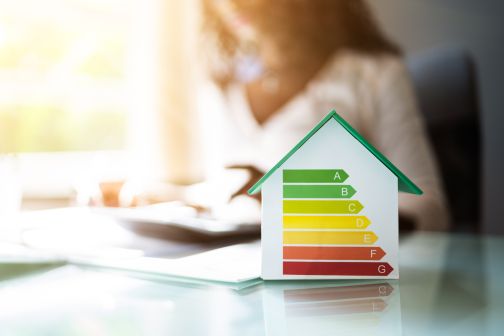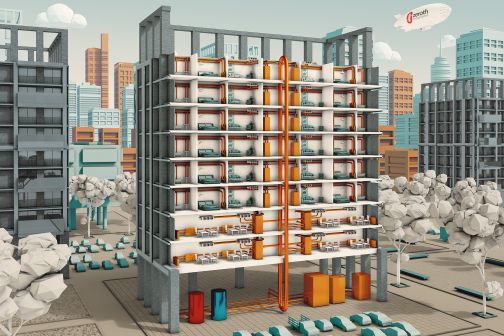Heat pump COP & EER and central plant SCOP in ambient loops

The coefficient of performance (COP) and energy efficiency ratio (EER) measure the efficiency of heating and cooling performance of heat pumps. As ambient communal loops that use in-apartment heat pumps rise in popularity in the UK, we should consider what the COP or EER of the in-apartment heat pump tells us about the efficiency of an HVAC system. We should also consider the seasonal coefficient of performance (SCOP) of the central plant and how this helps us project the energy efficiency and calculate the carbon reduction achievable through the correct specification of an ambient loop.
The construction industry is adapting to the challenges of accelerating efforts to achieve the 2050 net zero carbon target and tightening regulations. Although the emphasis is still on a fabric first approach, the uplifted Part L, and forthcoming Future Homes Standard, look beyond improving the thermal efficiency of our buildings and focus heavily on reducing energy use and its carbon impact. With at least 31% carbon reductions required by 2022 and 75% reductions by 2025, low carbon technologies are likely to become the primary source of heating and cooling in our buildings. This is likely to normalise the specification of communal ambient loops in larger residential and mixed-use developments as we move away from fossil-fuels and towards the electrification of heat.
Why the electrification of heat, and how can COP and EER help us understand the positive impact of heat pump specification on carbon emissions?
COP and EER help us to understand the heating and cooling efficiency of a heat pump. They can also help us project the relevant energy consumption and carbon emissions of a solution. You can find out more about heat pump COP and EER here.
Once calculated, the energy consumption of a heat pump can be multiplied by its carbon emission factor (CEF) to derive the carbon emissions of the energy source the heat pump uses. This links back to the primary energy factor (PEF) which is the amount of energy required to generate one unit of the electricity used by the heat pump. Combined, they show the total amount of energy that must be generated, and the carbon emissions of generating that energy, and are the energy factors which become fundamental for understanding compliance under the new uplifted Part L guidance.
As carbon remains a core benchmark of compliance, we are increasingly moving towards the electrification of heat in residential developments to achieve the nearest carbon reduction target of 35%. However, why can’t traditional combined heat and power (CHP) systems get us there?
The Standard Assessment Procedure (SAP) for Energy Rating of Dwellings, 2012 version, assumes that the CEF of electricity is almost 2.5 times more than that of gas. However, the introduction of SAP10 will reduce the CEF of electricity by more than a half, from 0.519 CO2/kWh to 0.233 CO2/kWh, whilst changes to other fuels will be negligible. The predictions for SAP10.1 go even further with a reduction of CEF for electricity to 0.136 CO2/kWh as our grid continues to decarbonise. The table below illustrates the changes SAP10 will introduce and the expectations for SAP10.1:
The referenced media source is missing and needs to be re-embedded.
When we consider the COP and EER of heat pumps, compared to that of CHP, it becomes clear that achieving the carbon reductions required using gas powered heating systems will be almost impossible.

Why are communal ambient loops seen as the technology for the future?
The design of ambient communal networks, such as the Zeroth Energy System by Glen Dimplex Heating & Ventilation (GDHV), combines the efficiency of heat pumps with the benefits of a low temperature central loop. The ambient loop, which is maintained at 25°C, supplies in-apartment heat pumps with the energy required to provide space heating, domestic hot water and comfort cooling.
The referenced media source is missing and needs to be re-embedded.
We have already considered how the efficiency of a heat pump can help increase the energy efficiency and lower the carbon emissions of a dwelling. The design of communal ambient loops offers further benefits, including but not limited to:
- A reduction of heat distribution losses and overheating associated with more traditional high temperature networks
- The specification of renewables such as air source heat pumps in the central plant
- Potential for a connection to a district heating network
The Zeroth Energy System is the only communal ambient loop that has to date been successfully installed in developments across the UK, providing valuable performance data on things such as the achievable distribution loss reduction. The Zeroth Energy System can significantly reduce heat distribution losses when compared to traditional high temperature networks. This helps to significantly improve the energy efficiency of a building and reduce overheating in communal spaces that have become a challenge in insulated residential buildings with CHP systems. You can read more on the impact the Zeroth Energy System can have on overheating here.
The flexibility of the Zeroth Energy System means that connection to a district heating network is possible if required. You can read more on this topic here. Specification of a renewable energy source for the central plant, such as an air source heat pump, can further increase energy efficiency and reduce the carbon footprint of the residential development.
How does the SCOP of an air source heat pump, utilised as central plant, impact the efficiency of a communal ambient loop?
Whilst COP and EER help illustrate the differences between the carbon reductions achievable with various heating and cooling technologies, the climate of the UK means the load requirements for heat pumps change with outdoor temperature fluctuations across the seasons. SCOP indicates the average energy efficiency of the unit throughout the entire heating and cooling season and can be a more accurate marker of heat pump efficiency.
The COP for in-apartment heat pumps currently on the market varies. This value is however less relevant when considered in the context of the overall ambient network solution, where its overall efficiency is better indicated by the SCOP of the central plant.
For example, a Zeroth Energy System installed with an air source heat pump as a central plant can offer overall system efficiencies of around 300%. This is a marked increase when compared with traditional centralised high temperature systems and shows the system outperforms other communal ambient loops currently on the market.
To find out more about the benefits that the Zeroth Energy System can bring to your next project, contact one of our HVAC specialists.








